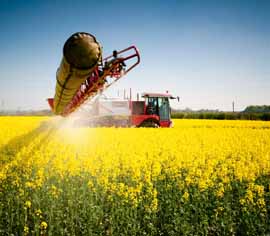Sclerotinia risk present despite dry conditions

Dry conditions have restricted sclerotia germination in most areas, but don’t underestimate the risk of sclerotinia infection in oilseed rape crops this season, growers are being warned.
Initial results from petal tests done by ADAS in Herefordshire show petal infection has already taken place in the west, despite germination of just 4% to date at the monitoring site, reports Peter Gladders of ADAS. It proves that dry weather doesn’t completely eliminate the risk of the disease developing.
“Soils in the east have been too dry for much germination,” he acknowledges. “But monitoring shows sclerotia have been germinating in the west and in North Yorkshire, so airborne spores are likely to coincide with mid-flowering.
“We know from previous experience that infection can still take place at low germination levels. And early indications are that it’s happening where there has been some moisture.”
Sprays applied this week in good conditions will provide the protection needed in case there’s a change in the weather, he adds.
Mark Hemmant of Agrovista agrees there’s no room for complacency, as soils are warm enough for germination and crops are coming into flower.
However, the fact that yield responses are achieved from flowering sprays, even in the absence of disease, makes the decision to spray easier, he says.
“The ideal is to have six weeks’ protection, to cover the entire flowering period, which only comes from a two-spray strategy,” he says. “So the early flowering sprays should be followed up within three weeks.”
His preference is for a strobilurin fungicide, such as azoxystrobin or picoxystrobin, for the first spray, followed by either a boscalid mix or prothioconazole at the later timing.
The alternative is to spray just once, which many will be tempted to do this season, he says. “The timing of that spray is more difficult, as the fungicides are all protectant. So they have to go on just before the infection period, which is harder to judge.”
Nick Myers of ProCam points out that crops which received just one mid-flowering spray last year had noticeable levels of sclerotinia later on, even though it followed a dry spring.
This year’s high crop prices make it far easier to justify a two-spray programme, he says. “They perform other roles too, helping to prolong the canopy and improve branching. Both could be important this year, given the dry conditions.”
Seed weevil
Seed weevil numbers are already above threshold in the earliest oilseed rape varieties and growers should remain vigilant, warns Mr Hemmant.
“The threshold is just two weevils per plant,” he says. “But many crops are at three or four weevils per plant already.”
The need to treat crops as they start to pod up will have an effect on fungicide choice for sclerotinia, he explains, as many of the pyrethroids used for seed weevil control shouldn’t be mixed with triazoles.
“The pyrethroid application usually goes in with a mid-flowering sclerotinia spray,” he says. “If you have got a seed weevil infestation, you may need to rethink your fungicide choice.”
Sclerotinia Watch Keep track of the risk factors in your region through our Sclerotinia Watch service, brought to you in association with BASF, ADAS and Agrovista. Take part and win an Apple iPod. |
|---|

